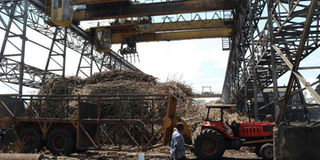What is going on in the sugar industry?

Chemelil Sugar Factory in Kisumu on September 12, 2016. PHOTO | TONNY OMONDI | NATION MEDIA GROUP
What you need to know:
One of the most notable observations today is that Kenya’s sugar industry is awash with ironies.
- To continue to allow the deprivation and poverty that is synonymous with much of the sugar belt is an aberration of responsibility.
Kenya’s sugar industry appears to be staggering from one crisis to another. What exactly is going on? It is useful to go back to the 1960s and look at what was envisioned and what actually took shape. The overriding concept then was to help make the country self-sufficient in sugar and at the same time create gainful opportunities for people.
Vast swathes of Nyanza and western Kenya were earmarked for sugar growing. In turn, Nzoia, South Nyanza (Sony), Muhoroni, and Mumias factories were built. Ramisi in Kwale and Miwani are older factories which have gone through their fair share of ups and downs.
One of the most notable observations today is that Kenya’s sugar sector is awash with ironies. Irony number one is that 50 years on, we still have to import around a third of the country’s sugar needs.
It is worth reminding ourselves about Mumias Sugar Company because for many years it was the blue-eyed boy of the industry. Indeed, it was so successful that one of its main challenges was getting enough cane to process.
For a good part of its history, it was managed as a purely commercial enterprise by a professional management company: Booker Tate of the UK. Not only did it make respectable profits, but dividends were declared.
Its performance was such that there was enough confidence to go public and it was listed on the Nairobi Stock Exchange. Its share price today is less than a quarter of what it was when it went public.
MANAGEMENT CONTRACT
The then Agriculture minister decided not to renew the management contract with Booker Tate and many would argue that that was when the fortunes of Mumias took a nosedive. To many of us, Mumias Sugar Company is a very public reminder of the sick side of the sugar industry.
However, the performance of the other factories was in some cases more chequered. I remember once standing with some managers of Nzioa Sugar Company, staring at the smoke coming out of the furnace. You see, the colour of the smoke told you whether it was working satisfactorily or not.
I recall a visit to Muhoroni, where the management and staff did their best to keep the old dinosaur of a factory ticking along. Their efforts were the equivalent of an industrial band aid operation.
Today we have a tale of two industries: the old ones, as detailed above, and the new boys on the block or, in the case of Ramisi, the revitalised ones.
The newer ones were able to start with a clean slate of modern equipment, no history of accumulated debts, and a slimmer labour force. What went wrong with the original factories? Basically, like many parastatals or government-controlled operations then, they were largely regarded as extensions of the power structure and many senior appointments to them were politically based.
Mismanagement, mediocrity, perennial losses, and shortage of cash were their hallmarks. One good example was how cane was paid for by weight and not by sucrose content.
LONG PERIODS
Millions of smallholder farmers eked out a miserable existence and waited inordinately long periods to be paid. Unfortunately, the hangover from this era is still there. Indeed, some would say the misery is far from over.
Various governments have postponed and dithered with the process of divesting themselves of these millstones, trying to instil a more commercial operation.
Admittedly the challenge of attracting serious investment into such privatised companies is daunting. First, there is the issue of smallholder acreages, which might appear socially sympathetic but are arguably uneconomic. Then there is the legacy issue. The factories are the equivalent of museum pieces that would need a lot of upgrading to enable them to compete in the current commercial environment. Thirdly, they are burdened with a multitude of debts which, unless written off, make them commercially unviable.
Last but not least, there is the challenge of pruning a bloated workforce complete with financial costs and social considerations.
The government and the country must bite the bullet on this one. To continue to allow the deprivation and poverty that is synonymous with much of the sugar belt is an aberration of responsibility.
Robert Shaw is an analyst on economic and social issues.





